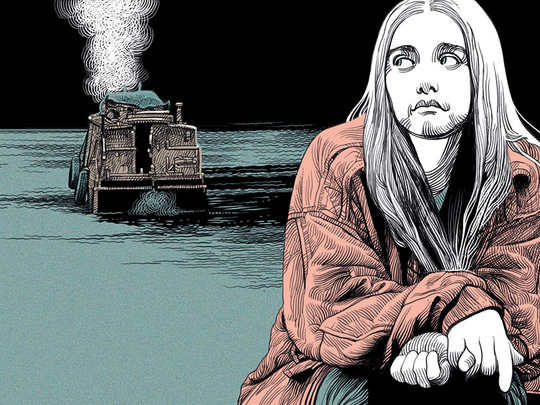
Everything Under
By Daisy Johnson, Jonathan Cape, 272 pages, £14.99
Gretel, the narrator of Daisy Johnson’s novel Everything Under, has spent a lifetime by canals. As a child in the Eighties, she lived with her mother Sarah on a boat, moored on the sullen waters; nearby was “bastard land, the mess of railways beyond the trees, the rotting lock”. When Gretel was 13, they moved on to that land, spending a three-year spell between hostels and B&Bs, ending up in a rented room above some stables.
Those days, as Gretel relates them to Sarah today, were unpleasant. “You drank and drank. Occasionally I hid the flask and there would be a fight... I drank whatever was in it to stop you from doing the same.” One night they went out for dinner; afterwards, Sarah pushed Gretel on to the homeward bus, and didn’t get on.
Gretel searched for her at first, but was happy enough to leave her behind. (“Forgetting is, I think, a form of protection.”) Assuming Sarah was dead, she lived a new life alone for 16 years, getting a cottage and a job updating dictionary entries. But Everything Under opens with the pair together again.
The now elderly Sarah is suffering “degeneration”, her mind becoming more and more absent, her body failing her. She remains plaintive and crabby by turns, but nowadays, when she puts things in the wrong place or barks orders at Gretel, it could be by accident or design. One morning, she starts to shake with “exhaustion or anger”, turns to Gretel, and demands: “Tell me how you found me.”
Gretel goes back to the start. Her childhood was one of sequestration, in both space and speech; she and Sarah had their own private dialect, “sills” for “the noise the river made at night”, “harpiedoodle” for a mishap. Now, as an adult, she’s been stuck on the definition of “break” for some time. As in Eley Williams’ 2017 Attrib., Johnson turns an obsession with words into a symptom of the longing to connect, to feel at home.
Still, those canals and that language might have been home forever — the pair felt, Gretel remembers, “like the last people on earth” — except that a teenager called Marcus appeared, a boy born “Margot” who secretly bound his (her) new breasts with cling-film. Their life on the water begins to end when Sarah, who always knew Marcus’s secret, sends her daughter outside for “sheesh time” — a while alone — and brings Marcus into her bed.
Everything Under, now shortlisted for the Booker, is a challenge. Like any mystery, it depends on inching towards a revelation, but its movement isn’t linear: we switch between the present (life with Sarah), the recent past (how Gretel found her), and the distant past (the days on the canal), and as well as that, we keep heading sideways, into and out of the tale of how Marcus found them originally.
Those latter chapters are Johnson’s best, haunting and atmospheric, as Marcus moves across the land alone, pursued by a mysterious creature known as “the canal thief”. But for all their self-contained skill, recalling Johnson’s 2016 short-story collection Fen, they fit awkwardly into the unwieldy structure around them. For one thing, you know that the Marcus chapters aren’t memories, but must be — as Gretel admits — “hearsay, guesswork”.
Marcus initially seems like an interloper, then, unexpected and of alien provenance. In truth he’s neither of these things, though none of the trio sees why until far too late; it turns out that all the characters share relations more clotted than they had previously known. Johnson removes the novel from the everyday present by entwining it with Greek tragic myth, and this also explains her work to create an atmosphere of dread, where logic always feels a fraction askew.
The canals are locatable on a map but aren’t like the world we know. We come across eerie figures like Fiona, who originally told young Margot to leave home and sent her towards the waterways, on account of her ability to tell what the young girl was destined to do. The 21st century hasn’t the words to index that strange power: it’s “not second sight, more a knowing”. Everything Under is an English novel attempting to be ancient and Greek, and its intricacy becomes a little stifling as it strains to make more than one kind of sense.
What Johnson does capture so well, amid all this, is something not so strange at all: the paranoia of looking back at an imperfect childhood, and wondering what damage it has left the adult with. Little Gretel was never so bad. In one of the novel’s more eerily touching scenes, she plays “Knock Knock Wolf” with Marcus, sneaking up in silence as he faces a tree. At other times back then, and intermittently ever since, she’s been haunted by “the Bonak” — Marcus’s “canal thief” — which is, to her, the shape-shifting manifestation of her many fears.
In fact, Gretel says, when she recently found Sarah at the canal, the Bonak emerged from the woods and attacked them; not only that, but she saw Sarah kill it, and they ate its flesh together over an open fire. Suddenly you’re unsure what you’re reading, or how to imagine it. As the line between memory and fantasy blurs, Everything Under leans to the lightly frustrating. Johnson wants to have her narrative two ways: now more chillingly psychological, now more viscerally traumatic. She’s adept at the one, and sometimes the other, but not quite both at once.
–The Telegraph Group Limited, London 2018









-1549353214833_16a4a1597d8_small.jpg)
